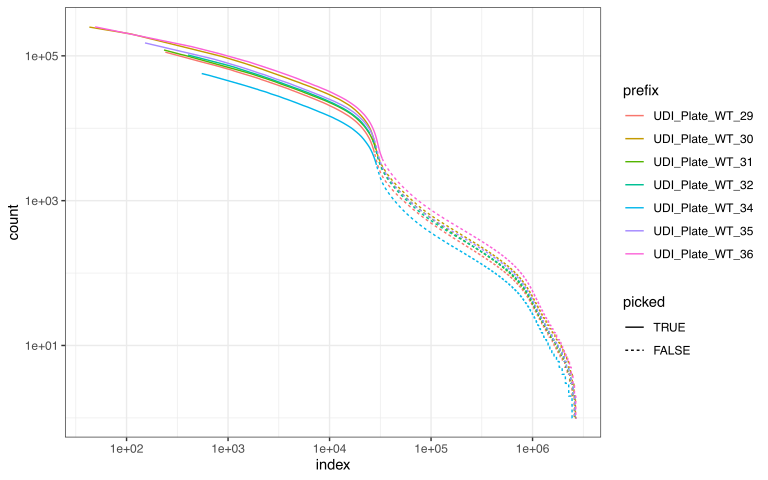First set up your Zorn/Bascet working directory as before. If you wish to run these steps on a SLURM cluster, see separate vignette and adapt accordingly.
library(Zorn)
bascet_runner.default <- LocalRunner(direct = TRUE, showScript=TRUE)
bascetRoot <- "/home/yours/an_empty_workdirectory"The first step in data processing is take the raw FASTQ files and identify which read belongs to which cell. Zorn can automatically figure out which files to use for what:
rawmeta <- DetectRawFileMeta("/home/yours/directory_with_raw_fastq")Depending on your input data, rawmeta might look like this:
| prefix | r1 | r2 | dir |
|---|---|---|---|
| UDI_Plate_WT_29 | UDI_Plate_WT_29_S43_L007_R1_001.fastq.gz | UDI_Plate_WT_29_S43_L007_R2_001.fastq.gz | /home/m/mahogny/mystore/dataset/250611/fastq |
| UDI_Plate_WT_29 | UDI_Plate_WT_29_S43_L008_R1_001.fastq.gz | UDI_Plate_WT_29_S43_L008_R2_001.fastq.gz | /home/m/mahogny/mystore/dataset/250611/fastq |
| UDI_Plate_WT_30 | UDI_Plate_WT_30_S44_L007_R1_001.fastq.gz | UDI_Plate_WT_30_S44_L007_R2_001.fastq.gz | /home/m/mahogny/mystore/dataset/250611/fastq |
| UDI_Plate_WT_30 | UDI_Plate_WT_30_S44_L008_R1_001.fastq.gz | UDI_Plate_WT_30_S44_L008_R2_001.fastq.gz | /home/m/mahogny/mystore/dataset/250611/fastq |
Prefix is the name of the library, of which there are two here. Note the paired input FASTQ files R1 and R2. Zorn has here detected that the libraries were sequenced on two separate lanes; by using the same prefix, these will be merged during the later sharding stage. Keeping input files from different lanes separate enables each FASTQ file to be processed on a separate computer and can thus be advantageous if you have large amounts of data.
If you have files that are awkwardly named for some reason, simply produce a data frame with the columns above, and provide as input for the next stage.
You can now parse the reads the figure out which cell they belong to, and any UMI information. The only thing you additionally need to specify is what type of data you have, where “atrandi_wgs” is for the Atrandi SPC-based MDA protocol for WGS.
BascetGetRaw(
bascetRoot,
rawmeta,
chemistry="atrandi_wgs"
)After debarcoding, you now need to (1) merge files belong to the same library, and (2) remove reads belonging to empty droplets. Furthermore, at this step you can also decide to split the cells across multiple “shards”, enabling parallel processing the data in later steps. This done in two steps, in which you first set up a “plan”. This is done using the following command:
debstat <- PrepareSharding(
bascetRoot,
inputName="debarcoded",
bascetInstance=bascet_instance.default,
minQuantile=0.99
)Before you proceed, you should perform a kneeplot analysis to see which cells you keep:
DebarcodedKneePlot(
debstat,
filename = "kneeplot.pdf" #optional
)This is just a histogram of reads per barcode. (downsampling for speed causes cells of low indices to not be shown, worry not!) The didagram however tells you * how many cells you have * how much free-floating RNA/DNA you have in your background (empty droplets/SPCs) * how distinct cells are from background
An example kneeplot for Parse biosciences RNA-seq data is shown below. You want to to include slightly more cells than the knee indicates. For Atrandi microbial WGS data, knee plots cannot be trusted, and you may want a fair bit more to account for lysis differences (see our manuscript). Including too many cells will slow down later steps but you can reduce the number of cells at any point. Adjust the cutoff using the previously set minQuantile parameter.

Once you have a plan you are happy with, you can proceed with shardification. At this step you can also choose to create multiple shards. This is only relevant if you wish to parallelize the workflow using SLURM, as the number of shards decides how many nodes you can use in parallel. If you run everything on your own computer then we advise only creating one shard, as there is no benefit to having multiple and it is more likely to cause mistakes.
BascetShardify(
debstat,
numOutputShards = 1, #shards per library; increase to spread the workload over more computers
runner=SlurmRunner(bascet_runner.default, ncpu="4")
)Additional trimming
Bascet only does rudimentary trimming. We recommend trimming the reads further. To do this, first convert your data to FASTQ format:
### Get reads in fastq format
BascetMapTransform(
bascetRoot,
inputName="filtered", #default; can omit
outputName="asfq",
out_format="R1.fq.gz"
)Now use FASTP to perform the trimming:
### Get reads in fastq format for BWA
BascetRunFASTP(
bascetRoot,
numLocalThreads=10,
inputName="asfq",
outputName="fastp"
)If your plan is to perform alignment, then the resulting fastp FASTQ files can be used as input (don’t forget to specify inputName=“fastp”!). If you want to instead get a TIRP file, you can convert it back:
BascetMapTransform(
bascetRoot,
"fastp",
"new_filtered",
out_format="tirp.gz"
)You now have a TIRP file again, equivalent to the first shardified output. Don’t forget to specify inputName=“new_filtered” to later commands, as the default is to use “filtered”